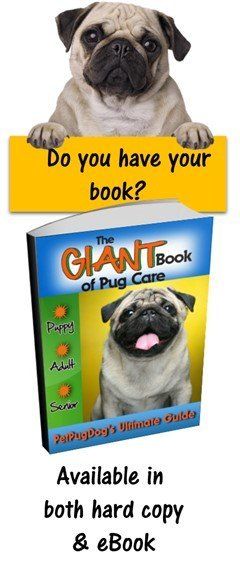The Pug VS Other Breeds
Overview
The number of different types of dog breeds in the world is climbing close to the 400 mark, including both recognized (200+ per the AKC) and 340+ by the FCI) and those that are working their way to recognition (just about every year or so, at least several more breeds become official).
With all of these different breeds, owners of Pugs may wonder where, exactly, the Pug fits in. How does he compare in size? What about general appearance or original purpose?
There are other ways to compare as well, such as those that were developed in the same country.. Those that share some of the amusing personality traits... or those that share some of the same physical traits such as the shortened snout that makes this a brachycephalic breed.
Whether you already have a Pug and want to see how he stacks up against other dogs or are looking to bring one into your family and want to see how he compares to others, this is a great place to start.
Classifications - Group
In regard to the AKC, breeds are classified in different groups and sub-groups. The main groups are:
- Herding Group
- Hound Group
- Non-Sporting Group
- Sporting Group
- Terrier Group
- Toy Group
- Working Group
- Miscellaneous Class (for breeds that do not fit into any of the above categories)
The Pug is part of the AKC Toy Group.
This is comprised of the smallest breeds.

Photo, left to right: Chihuahua, Yorkshire Terrier, Pomeranian, Toy Fox Terrier, Pug
The Pug is the largest of all within this group (though the Manchester Terrier can exceed the Pug on its highest end). There are 21 breeds in total:
Affenpinscher:
6.4-13 lbs.(2.9-5.9 kg), Brussels Griffon:
8-12 lbs. (3.6-5.4 kg), Cavalier King Charles Spaniel:
13-18 lbs.(5.9-8.2 kg), Chihuahua: 3-6 lbs.(1.4-2.7 kg), Chinese Crested:
5-12 lbs.(2.3-5.4 kg), English Toy Spaniel:
8-14 lbs.(3.6-6.4 kg), Havanese:
10-16 lbs.(4.5-7.3 kg), Italian Greyhound:
8-11 lbs.(3.6-5 kg)...
... Japanese Chin:
3-15 lbs.(1.4-6.8 kg), Maltese:
7-9 lbs.(3.2-4 kg), Manchester Terrier:
12-22 lbs.(3.6-10 kg), Miniature Pinscher: 8-11 lbs.(3.6-5 kg), Papillon:
7-10 lbs.(3.2-4.5 kg), Pekingese:
7-14 lbs.(3.2-6.4 kg), Pomeranian:
3-7 lbs.(1.4-3.2 kg), Toy Poodle:
6-9 lbs.(2.7-4 kg)...
... Pug:
14-18 lbs.(6.4-8.2 kg), Shih Tzu:
9-16 lbs.(4-7.2 kg), Silky Terrier:
8-10 lbs. (3.6-4.5 kg), Toy Fox Terrier:
4-7 lbs. (1.8-3.2 kg) and the Yorkshire Terrier:
4-7 lbs. (1.8-3.2 kg).
Purpose
A breed's purpose refers to the intentions behind the original development of the breed. In a broad sense, breeds are either work or companion dogs. Work has many sub-categories, both of which are part of the AKC and those that are not. This includes pastoral (herding or guardian), hunting and guard (private and military).
Today, many of the breeds in the working groups are indeed companions, however they have retained traits (high scenting abilities, instinct to chase, thick coats to endure cold weather, an aptness for swimming, strength, etc.) that correlate to their original purpose.
The Pug is in the companion group.
Breeds in this group are those in which their original purpose was solely to provide companionship to their humans. And this is a great group to be in when it comes to having a canine family member. Companion dogs, over hundreds of years and over generations of development, were bred specifically to be happy, obedient, loyal, friendly companions. They make exceptional canine family members.

Photo, left to right: American Eskimo, Chihuahua, Dachshund, Miniature Pinscher, Pug
There are 61 breeds that are within the companion group, including the Pug. Some overlap with the toy group and some do not. And it is quite an eclectic group as seen in the above photo of some examples of companion breeds, with the American Eskimo, Chihuahua, Dachshund, Miniature Pinscher, and the Pug.
Country of Origin
Different dog breeds have originated in literally every country from A (Argentina) to Z (Zimbabwe ), with 60+ countries around the world taking credit for a breed's existence.
The Pug's country of origin is China. There are 16 breeds that originated in China: the Guzui (Bone-mouth), Chinese Chongqing Dog, Chinese Imperial Dog, Chow Chow, Japanese Chin (origins in China, despite the name), Kunming wolfdog, Llaso Apso, Miniature Shar Pei, Pekingese, Pug, Shar Pei, Tibetan Mastiff, Tibetan Spaniel, Tibetan Terrier, Tugou, and the Xiasi Dog.
Looking far back to 400 BC, there are drawing, carvings and statues that depict dogs thought to be the Pug's ancestors. One was the Lo-sze (Lo-Chiang-Sze, modern Foo dog). Much of the Pug's exact history is unknown; in his early development, all records were destroyed by Emperor Chin Shih Huang in an effort to hide the secrets of the Pug.

Photo, left to right: Chow Chow, Pekingese, Shih Tzu, Pug (fawn and black)
Other dog breeds that have a connection to the Lo-sze (foo dog) or are also ancient breeds of China (connected to 'lion dogs') are the Chow Chow, Pekingese and the Shih Tzu (originated in Tibet and then been developed in China).
Cephalic Index (Face Shape)
This is the method of classifying canines based on their head shape, and more specifically, by the length of their muzzle. There are 3 main categories :Doclichocephalic (long), Mesaticephalic (medium) and Brachycephalic (short).
The Pug is a Brachycephalic breed.
This can make exercise
a bit tricky - especially in the summer
and due to compacted breathing passages and other internal structures, breathing issues
be present as well.
Having a short snout is not a natural occurrence; this is a physical trait that was purposefully bred into some breeds. There are 32 Brachycephalic breeds, including the Pug (though the extent of the compacted face varies from moderate to extreme).
The breeds are: Affenpinscher, American Pitbull Terrier, American Staffordshire Terrier, Bichon Frise, Boston Terrier, Boxer, Brussels Griffon, Bulldog, Bullmastiff, Cane Corso, Cavalier King Charles Spaniel...
... Chihuahua, Chow Chow, Dogo Argentino, Dogue de Bordeaux, English Mastiff, French Bulldog, Japanese Chin, Lhasa Apso, Maltese, Neapolitan Mastiff...
... Newfoundland, Pekingese, Presa Canario, Pug, Shar-Pei, Shih Tzu, Silky Terrier, Tibetan Spaniel, Valley Bulldog and Yorkshire Terrier.
Photo, in order: Boxer, Bulldog, Cavalier King Charles Spaniel, Dogue de Bordeaux,
French Bulldog, Japanese Chin, Shar-Pei, Pug
Wrinkles
There are several theories about why certain dog breeds have wrinkles, though some or all of them may be the answer, as they apply differently to different breeds.
One theory proposes that the wrinkles block out other scents, allowing the dog to hone in when scouting or taking chase (as may be true for the Bloodhound). Others claim that for some breeds, such as the Bulldog, excess wrinkles were an asset to have when fighting, as it protected the face. Still, for others, wrinkles may simply been a desired look that set the breed apart from so many others.
Though it may not hold true for all breeds with wrinkles, in regard to the Shar Pei, researchers are now able to determine that its extreme wrinkles are due to a hereditary disorder called mucinosis, which causes the body to over-produce hyaluronic acid. This then accumulates under the skin, leading to a deep wrinkling effect.
While there is some overlap between brachycephalic dogs and those with wrinkles, there the Bloodhound is a notable exception. While wrinkling varies from just the face to the entire body, the 12 top breeds known for their wrinkles (face or
full body) are: the Basset Hound, Boxer, Bullmastiff, Bloodhound, Dogue De Bordeaux, English Bulldog, English Mastiff, French Bulldog, Neapolitan Mastiff, Pekingese, Pug, and Shar Pei.

Photo, in order: Bullmastiff (via Wikimedia Commons, Athor: PIknowk9 ), Bloodhound, English Bulldog (via Wikimedia Commons, Athor: Pleple2000),
Neapolitan Mastiff (via Wikimedia Commons, Atrhur: Smok Bazyli), Dogue De Bordeaux, and the Pug.
Intelligence
When people are trying to ascertain just how smart a particular dog breed is, there actually not a lot of varied sources to go on.
Out of the over 33,000 vertebrate animals that exist on Earth (and of course not even a fraction have been tested for intelligence), the canine ranks at #13 (the orangutan, bottlenosed dolphin, chimpanzee, elephant, crow, African Grey Parrot, pig, rat, squirrel, raccoon, Veined Octopus, and the pigeon are above them).
We do know that canines in general are very intelligent; they are able to feel many emotions that humans do, from jealousy to love. In general, they have the intelligence of a 2.5 year old human.
Then, in regard to specific dog breeds, most referred to source is The Intelligence of Dogs, a book by profession Stanley Coren (pub. 1994).
It is a bit controversial and very limited. Dogs were only judged on their ability to obey commands and they were scored by 199 trial judges from the AKC and CKC in regard to what they witnessed in the show ring. Nevertheless, this is the source that most people refer to.
131 dog breeds were placed into 6 groups of intelligence:
- Brightest Dogs
- Excellent Working Dogs
- Above Average Working Dogs
- Average Working/Obedience Intelligence
- Fair Working/Obedience Intelligence
- Lowest Degree of Working/Obedience Intelligence
The Pug ranked #57 in the grouping of 'Fair Working/Obedience Intelligence'.
Do keep in mind, this was very limited and really does not take into account that some dogs do not choose to listen to commands (the Pug is indeed a free thinker).
Some breeds that scored far above the Pug
were the Border Collie (#1 in the 'Brightest' category), the Cocker Spaniel (#20, in the 'Excellent Working Dogs' category, the Dalmatian (#39, in the 'Above Average Working Dogs' category and the Alaskan Malamute (#50, in the 'Average Working/Obedience' cateory).
Breeds that scored very close to the Pug
were the Norfolk Terrier and Sealyham Terrier (both tied at #56) and the French Bulldog (#58).
Breeds that scored lower than the Pug
include the Beagle (#72, in the 'Lowest Degree of Working/Obedience'), the Bloodhound (#74) and the Afghan Hound (#79).
Did you catch these articles?
Pug Dog Winter Care
- All you need to know about prepping for and taking care of your Pug in the wintertime.
Pug Dog Drooling
- How much is normal, what's too much and reasons why a Pug may drool excessively.
Top 15 Pug Dog Care Tips
- A rundown and recap of care guidelines.
When a Pug is Always Hungry
- While this breed does often have a hearty appetite, constant need for food can be a red flag that some changes need to be made.
Pug Dog Arthritis
- What you need to know about this disease that strikes many senior Pug dogs.
Pug Dog is Peeing in the House
- Why a Pug does this and exactly how to stop it.
Training a Pug to Stop Begging
- It's hard to say no, but this is a bad habit to have. Great tips to stop this sort of behavior.
Pug Dog Bad Breath
- Why this happens and what you can do to keep your Pug's breath smelling nice & fresh.
Things to do now:
Become a Member
(if you are not already a Member) -Receive reminders when we add new pages of information. You'll also be able to suggest a topic for us to write about; we always look to Member suggestions!
Check out The GIANT Book of Pug Care
- It takes a giant, detailed and breed-specific book to confidently care for a Pug through every stage of his/her life. Now you’ve found it!





